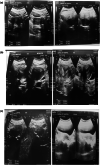Effectiveness of combined seeds (pumpkin, sunflower, sesame, flaxseed): As adjacent therapy to treat polycystic ovary syndrome in females
- PMID: 37324929
- PMCID: PMC10261760
- DOI: 10.1002/fsn3.3328
Effectiveness of combined seeds (pumpkin, sunflower, sesame, flaxseed): As adjacent therapy to treat polycystic ovary syndrome in females
Abstract
The formation and release of eggs during ovulation are impacted by high amounts of androgens. Seed cycling is powerful in the treatment of polycystic ovary syndrome (PCOS). For efficacy studies, 90 women with PCOS, between 15 and 40 years were selected from the department of gynecology, Tertiary care unit. Women with PCOS were divided into three groups (T0, T1, T2) (20 women/group). Among these three groups, the first was the control group (T0). The second group was the experimental group (T1). In T1, 20 women with PCOS were treated with a portion control diet and METFORMIN 500 mg tab/day for 90 days. The third group was also an experimental group (T2). In this group, 20 women with PCOS were also treated with another treatment plan for 90 days, in which portion control diet and seed cycling were included. During the 12-week efficacy trial, the highest follicle stimulating hormone (FSH) levels were found in the control group T0 (8.18 ± 0.13 mIU/mL). In T2, FSH falls from 6.545 ± 0.16 mIU/mL to 3.51 ± 0.13 mIU/mL throughout a 12-week period. Overall, a portion-controlled diet and seed cycling reduced FSH levels by 1.2% to 2.5%. LH value was 10.118 ± 0.1874 IU/L in the control group (T0), which climbed 12.82 ± 0.15 IU/L, but decreased from 10.62 ± 0.26 IU/L to 9.79 ± 0.17 U/L and 11.015 ± 0.24 IU/L 6.217 ± 0.167 IU/L in the other groups (T1, T2). It was determined that the LH levels were reduced by 1.5%-2% in T2. Conclusively, the seed cycling approach is effective and has significant results in women with PCOS. Seed cycling improves hormonal disturbance in women which promotes a healthy life.
Keywords: body mass index; endocrine; polycystic ovarian syndrome; seed cycling; ultrasound.
© 2023 The Authors. Food Science & Nutrition published by Wiley Periodicals LLC.
Conflict of interest statement
Authors declare that they have no conflict of interest.
Figures



References
-
- Ajith, D. M. (2022). Nutritional management of PCOS: A review article. Journal of Positive School Psychology, 6(8), 8979–8984.
-
- Alaee, S. , Mirani, M. , Derakhshan, Z. , Koohpeyma, F. , & Bakhtari, A. (2023). Thymoquinone improves folliculogenesis, sexual hormones, gene expression of apoptotic markers and antioxidant enzymes in polycystic ovary syndrome rat model. Veterinary Medicine and Science, 9, 290–300. 10.1002/vms3.958 - DOI - PMC - PubMed
-
- Bedigian, D. (2004). History and lore of sesame in Southwest Asia. Economic Botany, 58(3), 329–353.
LinkOut - more resources
Full Text Sources
Medical
Research Materials

